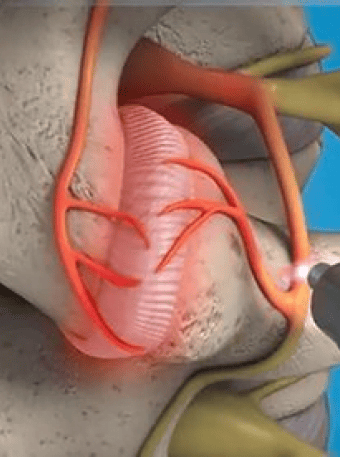
Endoscopic Facet Rhizotomy
- Home
- Treatments
- Endoscopic spine Procedure
- Endoscopic Facet Rhizotomy
The Endoscopic Rhizotomy is the least invasive outpatient procedure that effectively provides up to 5 years of pain relief for patients suffering from chronic low back pain and muscle spasms related to facet joint disease. When patients lean forward they are fine but leaning backward or standing for long periods causes significant low back pain. Patients suffering from low back pain will most likely see a pain management specialist, and receive facet injections, medial branch blocks or percutaneous radiofrequency rhizotomies (RFA) to relieve the pain. If the pain comes back or ideal long term pain relief was not achieved with the RFA, these patients are usually a good candidate for endoscopic rhizotomy treatment. Facet nerve blocks, or medial branch blocks, may be used to confirm the source of pain as coming from the nerve. Patients who have not responded to other conservative interventions such as facet injections, medication and physical therapy may be candidates for Endoscopic Laser Facet Rhizotomy.
Laser facet rhizotomy is a minimally invasive spinal surgery usually done as an outpatient procedure while the patient is under local anesthesia. During the procedure, the surgeon will make a small incision to insert an endoscope (a small flexible tube with a video camera) into the targeted location, so as to see the nerve branches. The surgeon then uses a laser to deaden these nerve branches thereby eliminating the patient’s pain.
FAQ's Endoscopic Facet Rhizotomy
- Lumbar Endoscopic
- Facet Rhizotomy
- Chronic low back pain
- Facet hypertrophy
- Facet joint arthritis
- Facet joint injuries
- Failed back surgery syndrome
- Whiplash syndromes
The patient is brought to the operating room and is administered with a local anesthetic and intravenous sedation. The surgical targets are marked at the skin level under fluoroscopic guidance (x-rays), and a small cut (about 7 mm) is made on the skin. Then, a tube is inserted to the target. The endoscope is then placed through the tube and the small nerve branches (medial branch) from the nerve root are identified.
A laser is then used to deaden the nerve branches, which only have a sensory function. Finally, the tube is removed, the incision is closed with a stitch or two, and the endoscopic facet rhizotomy is complete. Upon completion, the patient is encouraged to walk around and is free to leave the surgical center, with a companion, the same day. After a follow-up visit with the surgeon the next day, the patient can go home for a quick recovery.
Advantages of endoscopic facet rhizotomy include the following:
- Minimally Invasive
- Short recovery
- High Success rate
- Minimal or no blood loss
- Preservation of spinal mobility
- Small incision and minimal scar tissue formation
- Same day procedure with no hospitalization (outpatient procedure)
Video Spotlight
Blog
Surgery-Free Solutions
Expert Tips for Pain Management
Testimonials
Words From Our Patients
The treatment was very good and the doctor Faraz Ahmed was very kind to the patient and explained clearly the procedure of knee bilateral ha & botox And we were advised to do physiotherapy. We are very much satisfied. We would recommend this alleviate pain clinic. Thank you
Got treatment of Botox and HA for right knee arthritis a month ago and finding good relief from pain. Was treated by Dr Swagtesh Bastia who explained very well about the injections and the treatment was painless. The front desk staff were very kind and very helpful and physiotherapy was also done expertly, overall good experience
Alleviate Pain Management clinic has been a godsend for my mom's knee pain. She has been treated by Dr. Wiquar Ahmed. The attentive staff provided personalised care, and after her treatment, she's feeling remarkably better. Thank you for giving my mom the relief she deserves!
The clinic is super clean with a great OT and most importantly all the staff here are very helpful and considerate. My gratitude to Dr Roshan, the nurses, and support staff - they were always available to assist with any issues post procedure and they even made an extra effort to make a home visit for a follow up check-up. This team here is the perfect example of healing and care with a human touch. Thank you!!!!!
My wife had knee pain I have visited alleviate pain and consulted doc santhoshi now she is able to walk pain free and can do her daily activity than before.the physiotherapist here Dr akhila also helped her with few exercises and the staff here Abdul explained all the procedures well . Thank you PPL can visit here for pain relief






